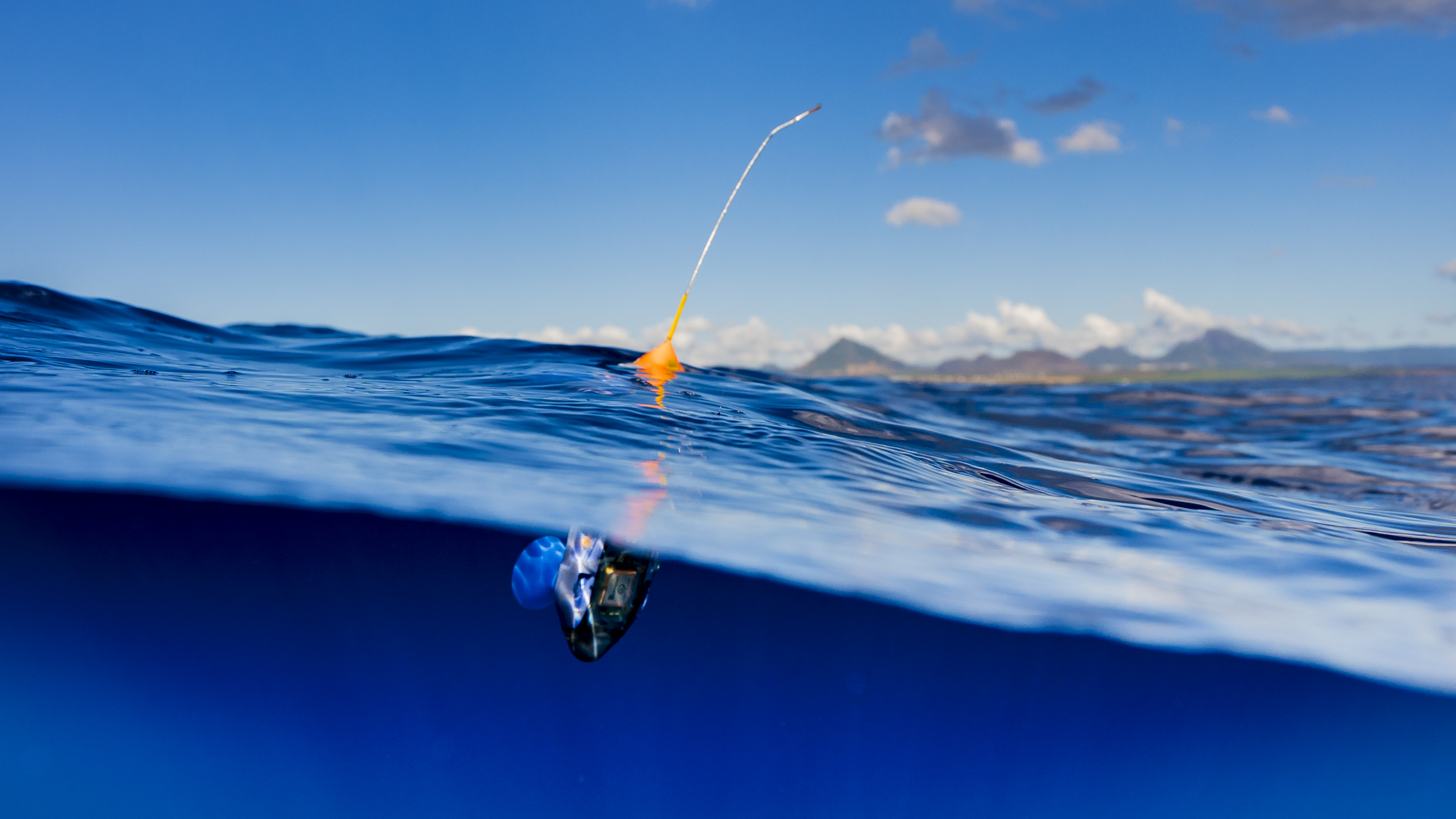
Every Whale Counts: Tracking Mauritius’ Sperm Whale Families
2025-07-31
Words by Spotted Fabri in collaboration with MMCO & photography by Spotted Fabri, Maëlle Jean-Louis and Vanessa Estrade.

The long‑awaited moment has arrived in Mauritius.
Although I came for this single mission, life showed me the island’s many faces and I savored every part of it. But now the focus is on the sperm whale tagging operation.
In the frame of the Quieter Western Indian Ocean project, together with Globice, Whale Conservation Society, the Spanish Research Council, Curtin University, Marine Megafauna Conservation Organisation (MMCO) and Adrien’s Dream, led by WCS (Wildlife Conservation Society) and funded by FFEM (Fonds Français pour l’Environnement Mondial) and partners we formed our team. Scientists, captains, photographers, volunteers… people brave enough to study these whales over time. Passionate about marine conservation and eager to devote their energy and time.
We work because these resident sperm whales are unique, and this project will deepen our understanding of their behavior to better protect them.
Introduction: Sperm Whales in Mauritius
Sperm whales (Physeter macrocephalus) are one of the few whale species to live year‑round off Mauritius, comprising a small resident local population of fewer than 30 individuals. They are categorized as vulnerable on the IUCN Red List, and their numbers remain low despite slow global growth.
MMCO’s Mission MAUBYDICK, active since 2013 (with studies from 2008), monitors this population through photo‑identification, genetic studies and tracking of sperm whales to assess population trends and identify critical habitats for conservation and marine spatial planning.

With only two dozen local whales, increasing human activity poses escalating threats — ship traffic, underwater noise pollution, and unauthorized tourism. Collecting behavioral data on sperm whales now is vital, before these Mauritian whales disappear.
Over the years, MMCO has identified more than 230 sperm whales, including both locals and visitors. The team knows every local whale by sight and has followed their lives closely from new births to old friendships. It’s like a big, underwater family album, built through years of patient research. This deep knowledge is essential when it comes to tagging. It helps scientists understand the different behavior patterns and personalities of each whale, making the data far more meaningful.
Local people are concerned about the whales and whale watching tour operators in Mauritius are afraid these animals are going to disappear from the region, losing their biggest asset but most importantly losing their lifelong friends.
Every whale counts.
A Deep Dive into the Sperm Whale World
Sperm whales are the largest toothed predators on Earth. They can dive to depths over 2000 meters and hold their breath for more than an hour. They use powerful echolocation clicks to hunt and communicate in a language we are only beginning to understand.
Their heads, which make up nearly one-third of their body length, house the spermaceti organ, a mysterious structure believed to aid in sound production. Females and calves live in stable matrilineal groups, while adult males roam alone and return occasionally to mate.
They live slowly. Socially. Wisely. And when they vanish from an area, they often don’t return.
Today, 25 sperm whales are here. Today we need to take care of them more than ever. Today, every whale counts.
Why Tag a Whale?

Tagging helps us understand whales. It gives us an insight into environments that we can only dream of.
In Mauritius, we are using a small, non-invasive device called a D-Tag. It gently attaches to the whale’s back with suction cups, staying on for a few hours before falling off on its own. No harm, no tracking chips, just data.
With this method, we can learn how deep they dive, how they move, and most importantly, how they use sound to communicate and navigate. It also helps us see how human activities — especially boat traffic — are affecting their daily lives.
By following their path through sound and depth, we can better protect them. Every tag gives us vital knowledge.
Every whale Counts.
The Tagging Technology
Our sperm whale tracking device is developed by Mark Johnson. It's a non‑invasive suction‑cup tag, built to attach gently to the whale’s skin without causing injury. It houses pressure and temperature sensors, accelerometers, magnetometers, hydrophones and VHF radio transmitters, all within a hydrodynamic design capable of withstanding dives to 3,000 metres — where light fades and whales spend most of their time, yet we know little about their behavior.
When the tagged whale surfaces, the tag emits a VHF signal. Recovering it is nerve‑wracking—these tags are unique in the world and irreplaceable. Only a few specialists know how to program and decode the captured data from deep diving whales.
Conservation Requires Collaboration
This isn’t a one-person job.
We coordinate with local ecotourism operators, marine biologists, NGOs, and scientists behind the tags who’ve spent decades refining them with respect at their core. Without trust and collaboration, there is no conservation.
We are here for the whales. Every sperm whale counts. We can't afford to lose them, so we gather the best that we can to protect them.
- Natacha, from the Spanish Institute of Oceanography, a marine biologist with decades of experience protecting cetaceans, oversees the entire operation. She is the one handling the tags.
- Vanessa, Lana, Paul, Noreen, Julian, Zbyscek and volunteers from MMCO and GLOBICE handle data collection, whale identification...
- Adrien, a life‑long whale‑watching operator, provides the boat and navigational expertise. He and Lana have defended these whales for years, treating them like extended family.

- Myself, Wildlife photografer and guide, i performed the tagging.
.jpeg)
Volunteers support the land station, monitoring tag signals and ensuring recovery.
The Tagging Day
After months of planning, the day arrives. At 04:50 AM we head out to sea… no resting, no wasted hours. Every second counts.
Adrien deploys a hydrophone to detect the characteristic sperm whale clicks and codas. These vary with behavior—communication, foraging, socializing—but much remains secret.
As soon as Adrien hears whales, Moby Dick, our boat, navigates toward them before other boats arrive, to minimize disturbance and capture more pristine behavior.
Putting our ears below the surface, putting our brain in to the mercy of the ocean.
We spot a blow, a fountain of air and water. The team begins identifying individuals and planning the approach.
My tool: a 7‑metre pole fitted with a holder that grips the tag. Pressed against the whale’s body, the suction cups engage and release the tag. It’s an art: an art that demands to act in the exact second. The exact moment when the whale is at the right distance, not too early, not too late- finding thebalance between delicacy and strength. We need precision and care. Smooth tagging ensures minimal whale disturbance.

Irene, a large adult female, one of the matriarchs of the group… surfaced near me. She blew water onto the deck. And the rush was at its finest.
I have been seeing her for some months and she is kind of one of the queens around the family.
Personally a very dramatic feeling.
I have seen Irene on numerous time this last months. And most of the times she was harased by boats. I felt sad for her each time. I felt that we needed to do something to protecct her. I did not want to bother her, not even one single time but... we need it. Because every whale...

This is what happens every day with them, boats and people just hunting the perfect photo. Harasing them without empathy
Now, the moment...
Being a whale watching guide never prepared me for this. I had experience from different parts of the world, but now, behind me, was my greatest mentor of the ocean—Natacha.
But we knew that.jpeg)

There are not many second chances. Now the pole felt heavy. The balance? Shaky.
I’ve spent weeks preparing, years dreaming.
Since the first time I tried this, I’ve felt out of place… trying, learning, hoping to do better.
Now I’m here. The closest I’ll ever be. The most direct way I can protect them.
The hours. The doubts. The sacrifices. The hope.
And this moment stands on the edge… between preservation or disturbance, between meaning or regret.
I breathe in. I steady my hands.
I remember why I’m here.
Each whale counts.
Each whale counts.
Each whale counts.
Then, I felt the moment… Adrien left the whale on my side, Natacha gave the go, a perfect synchro: a soft tap but with the exact force, and the suction cups sealed.
She was tagged.
Relief and joy filled the boat.
We repeated this process with 9 other whales:
Darren, Hope, Irene, Zoe, Speedy, Emy, Germaine
Most did not react at all... The suction cups cannot be more gentle with these animal.
Tracking and Data Collection
From then on, we track from afar. Let the whale go, let natural behavior unfold amid Mauritius’s busy maritime environment.
Our land team keeps eyes on the VHF signal from a hilltop. If the boat loses sight, they guide us back. A tiny tag, but massive stakes. Every role is critical.
The results? Data from depths of 1,000 meters, revealing behavior we could never witness otherwise.
This information is crucial.
For protection. For science. For the whales.
Conclusion: A Shared Mission
What we did was extraordinary. A tiny device. A devoted team. A vulnerable whale community..jpeg)



With science, collaboration, and courage, we strive to protect one of Mauritius’s most iconic marine species — the resident sperm whales, each with unique names, histories, and personalities.
Results that goes directly toward scientific research and part is available for whale watching companies. Very accurate information that will help the people that wants to do things right so they can showcase the beauty and uniqueness of this whales helping to conserve them.

Local NGOs and whale watching operators are fighting to take care of them and the tide is changing in favour of them. Inviting everyone to hop on, to hop on and take care of our fellow whales.
Thank you, whales, for welcoming us into your deep, mysterious world.
This mission was made possible through the support and dedication of many:
Led by WCS (Wildlife Conservation Society) and funded by FFEM (Fonds Français pour l’Environnement Mondial)
Globice, QWIO, the Spanish RESEARCH COUNCIL, MMCO, Adrien’s Dream, Curtin University passionate volunteers, and the local community.
We are especially grateful to the Mauritian authorities for granting research permits and to the National Coast Guard, who are working tirelessly to support whale conservation in these critical waters.
Every whale counts. And every effort matters.

I hope this article inspires the world to love the whales in the most correct way and also to be aware of how many incredible people are willing to work for them because in the end, these whales are beautiful, unique and essential for our life.
Im deeply concerned that the whales are being hunted for a picture, for likes and that just a few people empathize on them. This fanatism of swimming with them is going out of control and is very selfish to do it.
We need to remember that Every whale Counts.
Thanks for staying during the whole journey, if you want to hear more about the ocean please subscribe and let me know what you think about all this.
Have a beautiful day
Spottedfabri.png)







